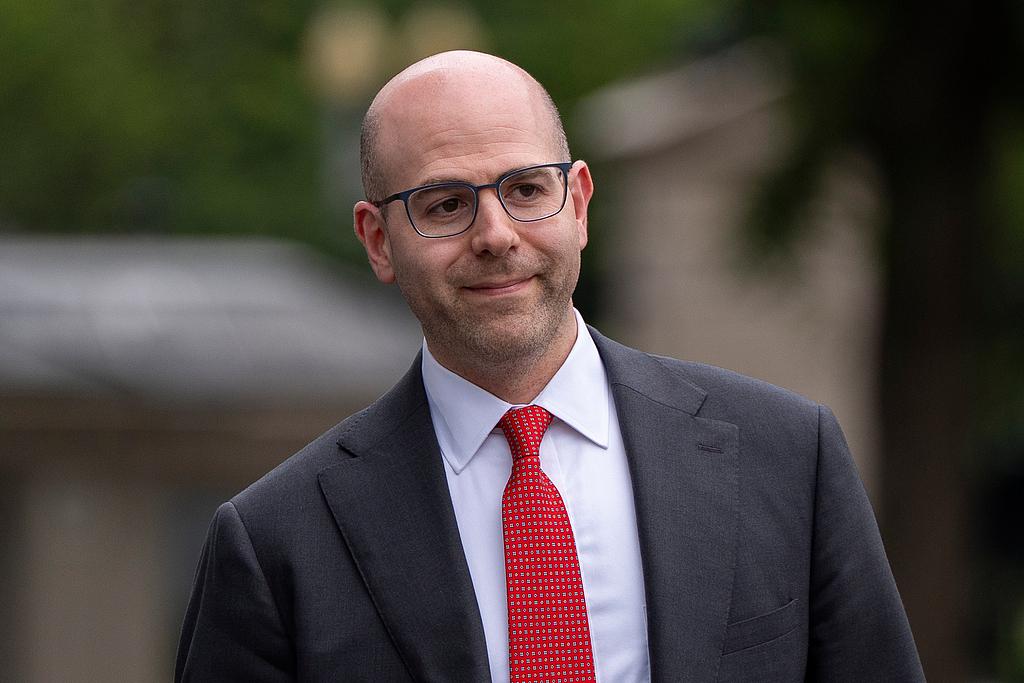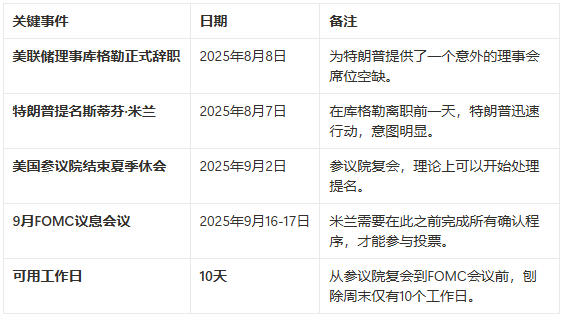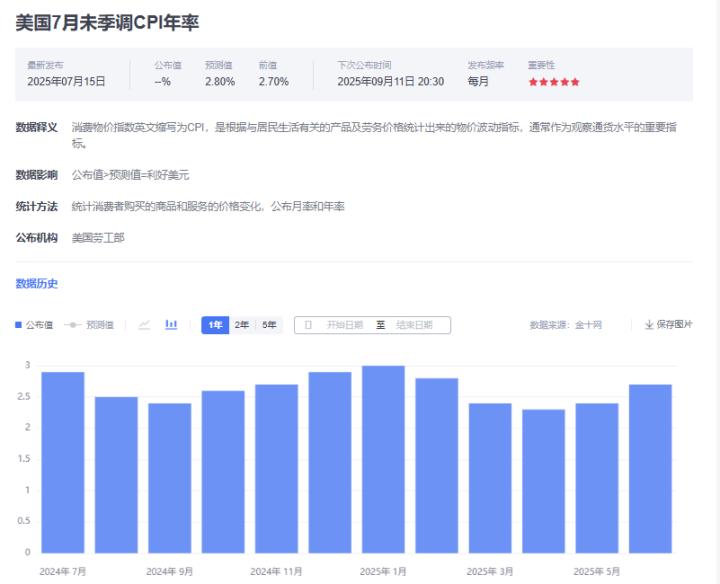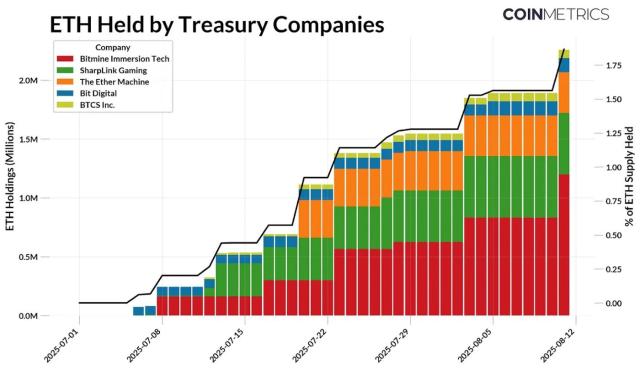
On the chessboard of macroeconomic trends, the global market's gaze was once fixed like a spotlight on a single focal point: whether September's US economic data would pave the way for the Federal Reserve's interest rate cut. Traders analyzed every employment report and inflation index as if deciphering an oracle, with Wall Street's core contradiction seemingly simplified to a mathematical problem of "economic recession" versus "inflation resilience".
However, in early August, an unexpected political variable burst in like a "stranger", instantly changing the nature of the game. The unexpected resignation of Federal Reserve Board member Adriana Kugler, followed by President Trump's nomination of Stephen Miran, his economic advisory committee chairman, on August 7th, suddenly escalated the market's core contradiction.
The question was no longer merely "whether economic data supports an interest rate cut", but "can the president's political will override the Federal Reserve's established procedures". This "stranger" named Stephen Miran not only brought short-term market fluctuations but, more importantly, carried a set of radical ideas that could fundamentally rewrite the game rules of the Federal Reserve and the US dollar system.
An "Impossible" Emergency Appointment
The initial market turmoil originated from an extremely delicate time difference. Trump hoped Miran could quickly enter the Federal Reserve and cast a crucial vote for rate cuts at the September 17th FOMC meeting. However, the institutional gears of US politics turn far slower than political figures' expectations.
Let's first look at this almost error-free timeline:

Just 10 working days to complete a full confirmation process for a Federal Reserve board member - including background checks by the Senate Banking Committee, hearings, committee voting, and final submission for full Senate debate and voting - is almost an impossible task in modern American politics. According to Brookings Institution data, the confirmation process for government nominations during Trump's second term has averaged a record 94 days.
Moreover, Democratic leaders in the Senate Banking Committee, such as Elizabeth Warren, have publicly labeled Miran a "Trump loyalist" and expressed serious concerns about his policy proposals, signaling they will use all procedural tools to delay this process.
Therefore, the first and most surface-level conclusion about this event is clear: Stephen Miran will almost certainly not vote in the September meeting. This event will have minimal direct impact on September's rate cut.
So, if not to influence September's rate decision, what is Trump's deeper calculation in playing this card? The answer lies in Stephen Miran himself and the ideas he represents.
Miran's "Arsenal": He Wants to Remake More Than Just Interest Rates
Simply labeling Stephen Miran as "Trump's man" or a "rate cut advocate" would severely underestimate his energy and the disruptive nature of his ideas. He is not a mere policy executor but an economic thinker with a systemic worldview, a "designer" attempting to reconstruct the system from its foundations.
His credentials are impressive: a Harvard University economics PhD, studying under Martin Feldstein, a famous economist from the Reagan era. Before entering the White House, he had key experiences at the Treasury and served as global macro strategy director at the renowned hedge fund Hudson Bay Capital, indicating expertise in both theory and market dynamics.
His true danger is reflected in two core publicly expressed ideas:
First, he advocates fundamentally "reforming" the Federal Reserve. In co-authored articles, Miran sharply criticizes the Fed for "group thinking" that led to serious past policy mistakes. His reform proposal is radical: subjecting the Federal Reserve's independence to the president's "will", giving the president easier power to dismiss board members, and even bringing its budget under Congressional appropriation control. This is no longer a policy line dispute but an attempt to dismantle the load-bearing wall of the Federal Reserve as an independent central bank.
Second, he possesses a comprehensive "US dollar weaponization" theory. In his widely circulated paper "Global Trade System Reorganization User Guide", Miran systematically elaborates on using tariffs and exchange rates as weapons to reshape the global trade landscape. He believes an overvalued dollar is the root of US manufacturing decline and envisions a "Mar-a-Lago Accord 2.0", advocating actively depressing the dollar through multilateral or even unilateral means. His toolbox includes not just tariffs as core negotiation chips but even "nuclear-level" options like imposing "usage fees" on US Treasury bonds held by foreign countries.
When these ideas potentially combine with a Federal Reserve board member position, an unsettling picture emerges: What Trump wants might be far more than just a few rate cuts. He wants a "weaponized" Federal Reserve that can implement his political will, deeply bind monetary policy with trade wars, and even be willing to shake the dollar's credit to achieve his economic objectives.
A Brilliant Stratagem Killing Three Birds and Bitcoin's "Institutional Hedging" Moment
Understanding Miran's ideological core and the "impossible timeline", Trump's brilliant stratagem becomes clear.
First, this is short-term pressure on current Chair Powell. Even if Miran cannot take his position, this nomination itself is a clear political signal, a public "warning" to the entire FOMC committee, alerting them to maintain consistency with the White House in monetary policy.
Second, this paves a medium-term runway for Miran to compete for the next Federal Reserve chair. Barclays analysts pointedly noted that Miran could be a "dark horse" for the chair position. Through this nomination, Trump has "crowned" Miran as his most trusted financial strategist on the global stage, bringing him into public view and accumulating capital for the 2026 succession battle after Powell's term ends.
Finally, this is a long-term agenda to "normalize" radical ideas. Throwing Miran's viewpoints into the market is itself a form of probing and stress testing. It forces the market to discuss and digest perspectives once considered "heretical", laying groundwork for potentially more radical future policies.
And what does all this mean for the crypto world, especially Bitcoin, far outside the traditional financial system?
For a long time, one of Bitcoin's core narratives has been as a "digital gold" hedging against inflation. However, when the world's only superpower and global reserve currency issuer begins publicly discussing "weaponizing" central banks and "weaponizing" national debt, Bitcoin's value narrative is subtly elevating.
It is no longer just a tool for hedging "economic risks" (like inflation), but has become the ultimate tool for hedging "institutional risks" and "political uncertainty".
The core of this event is the conflict between "human will" and "institutional rules". Milan's theory essentially hopes to place the "president's will" above the Federal Reserve's century-old rules. This forms the most vivid contrast in human monetary history with the core principle of the Bitcoin world—"Code is Law". Bitcoin's total issuance, output speed, and transaction rules are written in stone by globally open and transparent code, unaffected by any single strongman's will. This cold, predictable, mathematically-determined certainty is radiating an unprecedented attraction in a world where the risk of personal governance is increasingly rising.
When the safest "risk-free asset"—US Treasury bonds—can be viewed by its issuer as a tool to levy fees on other countries, global smart money will be forced to rethink the definition of "risk". This may drive some of them to seriously look for the first time at an asset that is truly independent of any sovereign state and not hijacked by any political agenda—Bitcoin.
Therefore, the arrival of this "stranger" Stephen Milan, regardless of whether he can ultimately sit at the Federal Reserve's discussion table, has provided the most authentic and profound macroeconomic footnote for Bitcoin's narrative as a "systemic hedging" tool in recent years. This may be the most thought-provoking signal behind this Washington political game.







